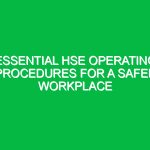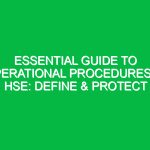Introduction
Hello team, and welcome to today’s Toolbox Talk! Today, we’re diving into a critical topic that affects us all in the workshop: Table Saw General Safety. Table saws are powerful tools that can make our jobs easier, but they also pose serious risks if not handled correctly. Understanding and practicing Safety Measures can prevent accidents and ensure that we all go home safe at the end of the day. So let’s explore essential Safety tips that will help us work effectively and safely with table saws.
Understanding the Risks
Before we jump into the safety tips, let’s take a moment to understand the risks associated with table saws. According to the U.S. Consumer Product Safety Commission, thousands of injuries occur each year due to improper use of table saws. These injuries can range from minor cuts to severe amputations. The main risks include:
- Contact Injuries: Accidental contact with the blade can cause severe injuries.
- Kickbacks: This occurs when the material being cut is forcibly thrown back towards the operator.
- Noise Hazards: Prolonged exposure to the noise from the saw can lead to hearing loss.
- Dust Exposure: Wood dust can cause respiratory issues and other health problems.
Recognizing these risks is the first step in developing a culture of safety in our workplace. Now, let’s discuss how we can mitigate these risks through Table Saw General Safety practices.
Pre-Operational Safety Checks
1. Inspect the Table Saw
Before using a table saw, it’s essential to perform a thorough inspection. Check the following:
- Blade Condition: Ensure the blade is sharp and free from damage.
- Blade Guard: Verify that the blade guard is in place and functioning correctly.
- Power Source: Check that the power switch works and that there are no frayed wires.
- Table Surface: Ensure the table surface is clean and free of debris.
These checks only take a few minutes but can save lives. For instance, I once witnessed a colleague who neglected to check the blade condition, which resulted in a kickback that could have been avoided. Always take the time for these checks!
2. Use Personal Protective Equipment (PPE)
Wearing appropriate PPE is crucial when operating a table saw. Here’s what you should always wear:
- Safety Glasses: Protect your eyes from flying debris.
- Hearing Protection: Use earmuffs or earplugs to guard against noise exposure.
- Dust Mask: Prevent inhalation of harmful wood dust.
- Non-Slip Footwear: Ensure you have a stable footing while operating the saw.
Remember, PPE is your last line of defense. Don’t skip it! It’s easy to think, “I’ll be fine without it,” but it only takes one moment for an accident to happen.
Safe Operating Procedures
3. Maintain a Clear Work Area
A cluttered workspace is a recipe for disaster. Always keep the area around the table saw clear of unnecessary tools and materials. This allows for:
- Safe Movement: You need space to maneuver safely.
- Quick Access: In case of an emergency, you want to be able to exit quickly.
For example, I remember a time when a colleague tripped over a misplaced tool while trying to adjust the saw, leading to a near miss. Keep your workspace tidy!
4. Properly Adjust the Saw Settings
Before you start cutting, ensure the table saw settings are adjusted correctly:
- Height Adjustment: Set the blade height to match the thickness of the material.
- Angle Adjustment: If making angled cuts, ensure the blade is set at the correct angle.
Incorrect settings can lead to dangerous situations. Always double-check your adjustments before starting any cut.
5. Use the Right Technique
When operating a table saw, technique is everything. Here are some key points to keep in mind:
- Stand to the Side: Always stand to the side of the blade to avoid kickback.
- Feed the Material Slowly: Never force the material through the saw; let the blade do the work.
- Use Push Sticks: When cutting narrow stock, use a push stick to keep your hands away from the blade.
Imagine you’re cutting a long piece of plywood. If you’re standing directly behind it, a kickback can send it flying right at you. By standing to the side, you minimize that risk significantly.
Post-Operational Safety Measures
6. Turn Off the Saw After Use
Always turn off the saw and unplug it after use. This is a simple yet often overlooked safety measure. It prevents accidental start-ups, especially during Maintenance or when someone else needs to use the tool.
7. Clean Up the Area
After you’re done, take a few moments to clean up the workspace. Sweep away sawdust, put tools away, and ensure everything is in order. This not only maintains a safe Environment but also prepares the workspace for the next user.
Understanding Regulations and Standards
8. Follow Safety Standards
As part of our commitment to Table Saw General Safety, it’s crucial to follow all relevant regulations and company policies. Familiarize yourself with:
- OSHA Standards: The Occupational Safety and Health Administration sets regulations for safe machinery Operation.
- Manufacturer Guidelines: Always refer to the table saw’s manual for specific safety instructions.
Compliance with these standards not only protects you but also the entire team. Non-compliance can lead to serious legal repercussions and potentially dangerous situations.
Encouraging Engagement and Discussion
9. Open-Ended Questions
Let’s take a moment to engage. I’d like to hear your thoughts on the following questions:
- What safety practices have you found most effective while using a table saw?
- Can anyone share a personal experience where safety measures helped prevent an accident?
- What challenges do you face in maintaining safety when using the table saw?
Your feedback is invaluable as we strive to create a culture of safety in our workplace.
Conclusion
As we wrap up today’s Toolbox Talk on Table Saw General Safety, let’s remember the key points we’ve discussed. Regular inspections, proper use of PPE, maintaining a clean workspace, and adhering to safe operating procedures are all critical to preventing accidents and ensuring everyone’s safety.
Thank you all for your attention and commitment to safety. Together, we can foster a safe working environment where everyone can focus on their tasks without the fear of accidents. Let’s keep these safety tips in mind as we go about our work today!


